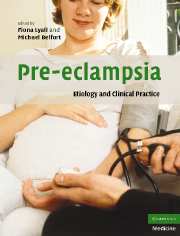Book contents
- Frontmatter
- Contents
- List of contributors
- Preface
- Part I Basic science
- Part II Clinical Practice
- 17 Classification and diagnosis of pre-eclampsia
- 18 Measuring blood pressure in pregnancy and pre-eclampsia
- 19 Immune maladaptation in the etiology of pre-eclampsia; an updated epidemiological perspective
- 20 Genetics of pre-eclampsia and counseling the patient who developed pre-eclampsia
- 21 Thrombophilias and pre-eclampsia
- 22 Medical illness and the risk of pre-eclampsia
- 23 The kidney and pre-eclampsia
- 24 Management of mild pre-eclampsia
- 25 Management of severe pre-eclampsia
- 26 The differential diagnosis of pre-eclampsia and eclampsia
- 27 Complications of pre-eclampsia
- 28 Central nervous system findings in pre-eclampsia and eclampsia
- 29 Pathogenesis and treatment of eclampsia
- 30 Anesthesia for the pre-eclamptic patient
- 31 Critical care management of severe pre-eclampsia
- 32 The role of maternal and fetal Doppler in pre-eclampsia
- 33 Pregnancy-induced hypertension – the effects on the newborn
- 34 Medico-legal implications of the diagnosis of pre-eclampsia
- Subject index
- References
31 - Critical care management of severe pre-eclampsia
from Part II - Clinical Practice
Published online by Cambridge University Press: 03 September 2009
- Frontmatter
- Contents
- List of contributors
- Preface
- Part I Basic science
- Part II Clinical Practice
- 17 Classification and diagnosis of pre-eclampsia
- 18 Measuring blood pressure in pregnancy and pre-eclampsia
- 19 Immune maladaptation in the etiology of pre-eclampsia; an updated epidemiological perspective
- 20 Genetics of pre-eclampsia and counseling the patient who developed pre-eclampsia
- 21 Thrombophilias and pre-eclampsia
- 22 Medical illness and the risk of pre-eclampsia
- 23 The kidney and pre-eclampsia
- 24 Management of mild pre-eclampsia
- 25 Management of severe pre-eclampsia
- 26 The differential diagnosis of pre-eclampsia and eclampsia
- 27 Complications of pre-eclampsia
- 28 Central nervous system findings in pre-eclampsia and eclampsia
- 29 Pathogenesis and treatment of eclampsia
- 30 Anesthesia for the pre-eclamptic patient
- 31 Critical care management of severe pre-eclampsia
- 32 The role of maternal and fetal Doppler in pre-eclampsia
- 33 Pregnancy-induced hypertension – the effects on the newborn
- 34 Medico-legal implications of the diagnosis of pre-eclampsia
- Subject index
- References
Summary
Pre-eclampsia remains one of the leading causes of maternal mortality in developing and industrialized societies and affects 2–6% of pregnant women (Duley, 1992; Hogberg et al., 1994; WHO, 1988). Eclampsia with or without evidence of intracranial hemorrhage is the single most lethal complication of pre-eclampsia/eclampsia. Deaths have also been associated with pulmonary edema, HELLP syndrome, renal failure and the development of hypovolemia (commonly due to concurrent abruptio placentae). Some of the factors that predispose to a poor outcome include inadequate access to medical care resulting in delayed hospitalization and substandard care arising from inappropriate management. The provision of medical facilities is a socioeconomic priority that may not be easy to implement. The development of skills and knowledge necessary to care for critically ill pre-eclamptic women is a far more attainable goal and should be widely taught to all categories of medical staff.
Obstetric critical care is largely dependent on information derived from small (usually observational) studies, although there are now some randomized studies that inform clinical practice. The absence of an overwhelming burden of epidemiological evidence does not preclude the need for intervention and some of the principles of management, especially those based upon expert opinion alone, may change in time as further epidemiological data become available.
This chapter will briefly outline pathologic changes in the major organ systems affected in pre-eclampsia, discuss the role of monitoring in the intensive care unit, and will address the specific complications of severe pre-eclampsia that necessitate intensive care.
- Type
- Chapter
- Information
- Pre-eclampsiaEtiology and Clinical Practice, pp. 476 - 488Publisher: Cambridge University PressPrint publication year: 2007



